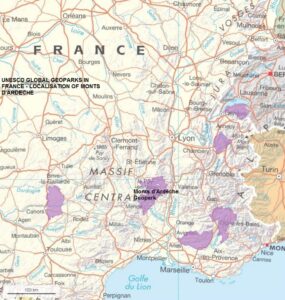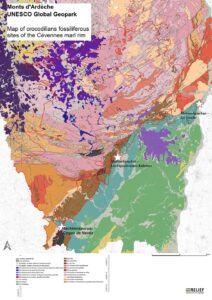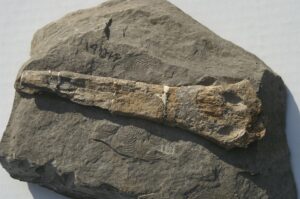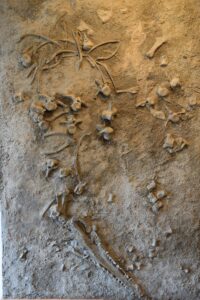Introduction
The Parc Naturel Regional des Monts d’Ardèche dates back to an initiative in 1992 by the local chestnut growers, and it was formalized on 9th April 2001. Y a decree of the Prime minister in Paris. The park is located in the western part of the Département Ardèche, and its perimeter was extended in 2013 to a few neighboring communes of Haute-Loire. The area functions as a strong tourist attraction, not only because of its underlying geology including very evident remnants of conical volcanoes, but also because of the rugged landscapes, the rivers, production of blueberries and chestnuts, terraced fields, religious history, and ancient mill buildings. The Parc was inscribed as a UNESCO Global Geopark since September 2014. It has an area of 228,000 hectares, and is occupied by about 76,000 people.
The territory is located on the eastern edge of the Massif Central, about 150 km south of Lyon city (Fig. 1). It is a transitional territory between the Rhône corridor and the wider Massif Central. From a geological point of view, the area is considered as a transition zone, including rich and diversified magmatic, sedimentary and metamorphic rocks reflecting a long history of tectonic plate movements and volcanism. All geological periods are represented from the Paleozoic to the present day, covering almost 550 million years of earth history. This great geological diversity and the density of sedimentary substrates has made the Monts d’Ardèche UNESCO Global Geopark territory a hotspot for paleontological research.
Carboniferous sedimentary deposits result from the erosion of the Hercynian chain, and form layers of sandstone which alternate with layers rich in organic plant materials from the lush forests that lined wetlands. Fossils of ferns can be found in particular. Permian sedimentary deposits near Largentière mainly comrpise conglomerates, fine sandstones and reddish to grey siltstones. These deposits include burrows, tetrapod tracks and traces of vegetation.
The remarkable richness and abundance of Triassic vertebrate tracks in the Monts d’Ardèche UNESCO Global Geopark is an exceptional ichnological heritage in France. To date, 15 tracksites and nearly a thousand individual tracks have been inventoried within the Geopark limits and its immediate surroundings (Fara et al. 2020). Middle Triassic ichnossemblages in the Ardèche illustrate pseudosuchian-dominated faunas and Late Triassic ichnoassemblages are dominated by dinosaur tracks and trackways.
Jurassic rocks on the edge of the Geopark bear witness to a warm-water, shallow marine environment thanks to its numerous fossils, including ammonites, belemnites, corals, gastropods, crinoids, bivalves.
Finally, a few clay and coal outcrops from the Neogene, to be found under basalt flows in the mountainous areas of the Ardèche, have shown fossils representative in particular of the Mio-Pliocene, including the rhinoceros Dicerorhinus megarhinus, the horse Hipparion, and the elephant Dinotherium.
The Parc Naturel Regional des Monts d’Ardèche is today pursuing this long tradition of paleontological research, in cooperation with universities, local associations and experts and other public or private partners.

Figure 1. Locality of the Monts d'Ardèche UNESCO Global Geopark, and the other French UNESCO Geoparks.
Geological Context and Areas of Paleontological Interest
The Mesozoic heritage in the Ardèche mainly originates from lagoons in the marine environment. This part of the succession begins with Triassic sandstones, and the Jurassic and Cretaceous are strongly represented by numerous limestones and marls. The Jurassic rocks include emerging tilted blocks representative of a variety of marine environments at diverse depths, all together forming a mosaic of sedimentary conditions. Sediments were deposited in the slowly opening Ligurian Tethys Ocean, evidence of lithospheric extension between the European and African plates, and the small Adria plate to the west (Piccardo 2008). As the African plate moved northwest and the Europe and Adria plates southeast, the Ligurian Ocean opened. It was floored by mantle peridotites through which mid-ocean ridge basalt melts percolated, forming alternating layers of volcanic and non-volcanic deposits on the sea bed.
During the Middle Jurassic, the Ligurian Ocean went through an episode which led to the deposit of marls on its margin. These were the future badlands which now stretch along the Cévennes border between La Voulte and Les Vans. Tectonic movements led to increasingly deeper sedimentation through to the Hauterivian (Early Cretaceous). In these marly environments which are typical of lower continental slopes, several fossils of Jurassic crocodilians have been discovered since 1958. Aligned along this marly Cévennes border, three sites have provided very interesting remains of marine crocodilians (Fig. 2); two are located in the territory of the Monts d'Ardèche Global Geopark (Lachapelle-sous-Aubenas and Les Vans), the third being located at its edge (La Voulte).

Figure 2. Map of crocodilian fossiliferous sites of the Cévennes marl rim.
Crocodilians from the La Voulte Geosite
The first discovery of marine crocodilians in the Ardèche was from La Voulte (Kuhn-Schnyder 1960). This was a skull of Metriorhynchus preserved in a nodule extracted from Middle Jurassic marls dated from the lower Callovian (Fig. 3), and kept at the Paläontologisches Institute und Museum der Universität Zürich (PIMUZ). In 1981 a second specimen was extracted, the skull of a probably juvenile individual of Metriorhynchus, now exhibited and preserved at the Muséum de l'Ardèche in Balazuc.

Figure 3. Skull of the juvenile Metriorhynchus found at La Voulte, showing snout pointing left, and crushed bivalve shells on either side.
The layers with crocodilian material material at La Voulte (Riou 2009; Riou & Morton 2010) are clayey marls (70% clay) which are laterally extensive and 3–7 m thick. They are laminated, blackish, brownish or red, and contain some discontinuous limestone beds and horizons with pyrite, calcareous or siliceous intraformational nodules. The surfaces of the beds are sporadically covered with imprints of Bositra buchi (Bivalvia, Posidoniidae) and Ophiopinna elegans (Ophiuridae) in more or less dense populations. There is also a great diversity of crustaceans, including abundant thylacocephalians, as well as dibranchiate cephalopods and some fishes (selachians, actinopterygians and coelacanths). According to study of the ammonites (Fischer and Riou 1982a), the layers from which the remains of crocodilians came are attributed with sufficient certainty to the Gracilis Zone (Koenigi sub-zone) known as the "Nave layer" [couche de Nave] of the lower Callovian (Elmi 1967). The presence of the ammonite Reineckeia anceps in the upper zone confirms the stratigraphic attribution.
La Voulte deposit is classified among the best Konservat-Lagerstätten of the world, sites showing the the conservation of soft parts. La Voulte is also particularly known for its richness of fossil cephalopods. In 1982 the oldest known octopod was discovered at this site, Proteroctopus ribeti (Fischer and Riou 1982b). The juvenile individual of Metriorhynchus was extracted from the same area as the oldest known octopod. The fossil bathyal fauna is related to marine environments more than 300 m deep. It includes fossils of vampire squid, large pycnogonids and numerous crustaceans, ranking the deposit as one of the 20 most exceptional paleontological sites in the world (Briggs 2001). The site is located in the north-eastern part of Parc des Mont d'Ardèche and is protected since 2006 as an Espace Naturel Sensible, belonging as a public property to Conseil Départemental de l’Ardèche (Domaine Départemental de Nature de La Boissine).
Crocodilians from the Lachapelle-sous-Aubenas Geosite
In 1986, the discovery of a Metriorhynchus in the Callovian marls in the eastern part of Lachapelle-sous-Aubenas village was a major scientific event. The specimen was extracted from alternating marl-limestone facies of the Vans layer (Elmi 1967); the lower part seems to correspond to the top of the Koenigi Zone. Young et al. (2010) attributed the fossils to the species Metriorhynchus hastifer (Eudes-Deslongchamps, 1868). Partially dislocated, it is one of the few existing sub-complete specimens of Metriorhynchidae with a complete skull. A cast of the specimen is currently on display at the town hall of La Chapelle sous Aubenas (Fig. 4).

Figure 4. High-fidelity cast of the Metriorhynchus skeletal remains presented at the town hall of Lachapelle-sous-Aubenas. In order to present the fossil to the public, a cast was made at the end of the 1980s, as the original fossil was too fragile to be regularly transported. This cast was made at the site before extraction of the crocodile.
Fossil remains of the Jurassic genus Metriorhynchus are scarce. They are found in Western Europe (France, Germany, Switzerland and England) and South America (Argentina and Chile). In France, remains are known from Jurassic areas in Poitou, Normandy (Callovian of the Vaches Noires, Calvados) and Ardèche. Metriorhynchus are known from Bathonian to the Kimmeridgian. Because of their rarity in the Middle Jurassic, the specimens from Ardèche provide important information. In particular, they confirm the genus was present in high seas and in deep marine environments. The genus seems to have disappeared in the Early Cretaceous with only a few specimens found in Alpes de Haute Provence.
Crocodilians from the Cirque de Naves Geosite
The geosite of Cirque de Naves (Les Vans) is located 500 m west of Hameau de Naves. Almost all Jurassic deposits are represented there and form a landscape of badlands, characterized by alternating layers of limestone and marl. All fossils discovered there (ammonites, belemnites, etc.) indicate a shallow (40–100 m deep) and muddy marine environment.
The discovery in 1998 of a marine crocodile of the teleosaurid Machimosaurus genus in the Middle Oxfordian layers is of major interest (Gagnaison et al. 2000; Young et al. 2014). The skeleton is only partial, consisting of a set of 26 bones (vertebrae and ribs) and one tooth, making it possible to establish that this crocodile was a juvenile individual not exceeding 3 m in length. It is worth noting the presence of numerous shark bites on the ribs. A more precise determination of the species was not possible due to the absence of the skull, pelvis and limbs. This is the only discovery of this genus in the Ardèche.
The fossiliferous zone where the specimen was collected is in the Assions layer (Elmi 1967), which corresponds to light gray and clayey limestones, compact or broken in badly delimited beds 20–45 cm thick. This level is a lumpy limestone which corresponds to the Plicatilis Zone of the Middle Oxfordian.
Since 2019, the Naves geosite has been promoted via an interpretation trail by the Monts d'Ardèche Global Geopark and Municipality of Les Vans. This trail, accessible to the public, presents the geosite in a dreamlike way, including a representation of the crocodilian, and channels visitors to prevent erosion and the risk of damage to fossil deposits.
For each of its geosites, Monts d'Ardèche Global Geopark contracts an illustrator artist who helps to immerse the public in a new environment (Fig. 5). This work does not always aim to faithfully represent a scientific object, but rather to create an artistic universe, attractive and intelligible to all audiences.
Figure 5. Poetic representation of the Naves crocodilian on the Geosite interpretation trail. In English, this reads, “At the bottom of the Jurassic sea; marls and limestones – 160- million years ago,” and then: During the Jurassic, the region is under the warm waters of the Tethys Ocean. A diversified and complex ecosystem is in place, including sharks, sea urchins, sponges, ammonites, belemnites and crocodilians... In this ocean, ammonites are the most abundant animals. Over time, sediments are deposited at the bottom of the ocean and form successive layers - or strata - of marly limestone. This process is called sedimentation. After the seas retreated, erosion gradually transforms the relief into its present form. But the limestone beds still preserve the fossils of extinct marine species. Did you know that? The study of the different strata allows us to identify several phases of marine advance and retreat.
Significance of the Crocodilians from the Ardèches
The Ardèches Jurassic localities have yielded crocodilians belonging to the two major clades of Thalattosuchia, the marine Mesozoic crocodilians, namely Teleosauridae and Metriorhynchidae (Bardet 1995). These represent widespread families, and a definite major step in crocodilian evolution, between the more terrestrial ancestral forms such as saltoposuchids and protosuchids from the Late Triassic and Early Jurassic, and the later, more terrestrial and freshwater-adapted mesoeucrocodylians and eusuchians of the Cretaceous and Cenozoic.
Machimosaurus belongs to family Teleosauridae, and in particular it has a slender, elongated snout and so presumably fed on prey without hard parts, whereas other teleosaurids with shorter, sturdier snouts, could attack harder prey. The genus Machimosaurus is the largest known crocodyliform in the Jurassic marine deposits and could reach a length of 7–8 m (Buffetaut 1982; Hua et al. 1993; Young et al. 2014). It is best known from the Upper Jurassic (Kimmeridgian and Tithonian) to Lower Cretaceous of England, France, Germany, Portugal, Switzerland and Tunisia. In France, Machimosaurus specimens are well known in the Middle Jurassic areas of Normandy and Poitou.
Metriorhynchids such as Metriorhynchus differ from teleosaurids by their more advanced adaptation to the aquatic environment (Wenz 1968). The absence of an armor of bone plates reinforces the suppleness of the body and reduces its weight. Bones of the skull are lightened, and their limbs are four swimming paddles. The tail has a caudal fin. These animals, which could reach a length of 3.50 m, preferentially frequented the open sea. Their diet probably consisted of fish and invertebrates.
The presence of these two genera of marine crocodilians in the fossil record of Ardèche, one of which is more closely adapted to the deep marine environment (Metriorhynchus) and the other closer to coastal areas in much shallower environments (Machimosaurus), allows us to better understand this wide variety of marine environments that make up a mosaic of sedimentary conditions in the Jurassic period. This is a case of major interest showing the geological interest of the territory of Monts d'Ardèche Global Geopark and its sedimentary edge.
Conclusion
This research will be further valorized in the next exhibition of the Monts d'Ardèche UNESCO Global Geopark planned at the visitor’s center in Jaujac in 2022 and 2023. Named "Disparus! Une histoire de la vie dans les Monts d'Ardèche" (Missing! A History of Life in Monts d'Ardèche), the exhibition will offer an opportunity to immerse oneself in the great adventure of paleontological research in the Monts d'Ardèche and to put into perspective past extinctions and the current sixth extinction. On this occasion, the metriorhynchid fossil from the Lachapelle-sous-Aubenas excavations will be presented to the public.
Conflict of Interest
The authors declare that they have no competing interests.
